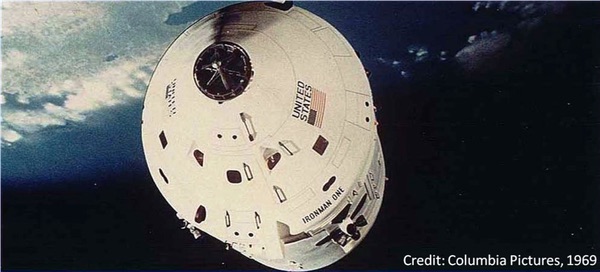Saving Colonel Pruettby John B. Charles
|
| But it didn’t have to end that way: Pruett didn’t have to die. |
Marooned was a pretty good space movie for its day (filming started in November 1968 and it first appeared in theaters in November 1969). Not unexpectedly—because nobody makes movies about boring successful space missions—a systems failure leaves the astronauts in an orbit that will outlast their oxygen supply. Drama ensues, and one of the astronauts, Col. Jim Pruett, sacrifices himself so his crewmates can live.
Caidin published an earlier version of Marooned in 1964.[1] In that iteration, Dick Pruett was a rookie astronaut stranded in orbit by a retrorocket failure on the final Mercury mission, rescued by fellow rookie Jim Dougherty on the very first flight of the new Gemini spacecraft. Caidin provided six appendices of calculations and reference material to buttress his story’s credibility.
In the 1969 version, Pruett, now an Air Force colonel nicknamed Jim, was a veteran astronaut in command of the first space station crew, and Dougherty, NASA’s chief astronaut and nicknamed Ted, piloted an unproven lifting body spacecraft on the rescue mission. The screenplay by Mayo Simon was light on technical information but its novelization[2] by Martin Caidin provided details aplenty. I have previously discussed Caidin’s style and inspiration (see “A tale of two Martins”, The Space Review, January 5, 2015).
Most importantly, Dick Pruett was rescued, but Jim Pruett was not. But it didn’t have to end that way: Pruett didn’t have to die.
Marooned was a story of the present day and the near-future. The hurricane that disrupts rescue launch operations was named Alma, just like the one that lambasted Florida in May 1970,[3] while the movie was still in theaters. For the movie’s events to be taking place in the seventh month of the planned year-long mission, as Caidin wrote, Ironman One would have had to have been launched in October 1969—just in time for the movie’s premiere in Washington, DC.
It was also a story with echoes of the recent past. The Ironman duo of Jim Pruett and Buzz Lloyd could only have been inspired by the real-life pairing of Jim Lovell with Buzz Aldrin on Gemini 12, dating Simon’s screenplay to late 1966. (Similar inspiration did not extend to the third crewman, Clayton “Stoney” Stone, whose unpoetic nickname befitted his no-nonsense attitude toward both routine spaceflight and impending doom.) Caidin’s subsequent novelization was still in work in January 1969 because he referenced the Soviet Union’s claim that its docking of two Soyuz vehicles formed a space station even though the linkup lasted only a few hours and did not have the capability for internal crew transfer.
As a movie, Marooned has its technical strengths. NASA’s contractors North American Aviation and Philco-Ford assisted with the realistic movie sets for the Apollo spacecraft and mission control, respectively.[4] The inside of the Ironman station looked like a realistic alternative concept for the McDonnell Douglas-built orbital workshop based on the Saturn rocket’s S-IVB stage.[5]
Marooned credibly depicted the human costs of routine, non-heroic long-duration spaceflight. It also presented the idea of cooperation between the American and Soviet space programs at the height of the Cold War in a way that reportedly encouraged the Soviet engineers then contemplating a joint Apollo-Soyuz demonstration spaceflight.
Its special effects, which look cheesy, clumsy, and even laughable to us today, looked, well, cheesy and clumsy in the pre-CGI days of 1969 but we didn’t laugh because we suspended disbelief. In spite of their appearance to our modern sensibilities, in 1970 they won Marooned its only Oscar for best visual special effects.[6]
| Eisele had confidence in the SPS, perhaps because he had not seen Marooned yet. |
Oscars aside, the movie and its novel have several technical flaws. That Caidin’s backstory posited a first space station mission as open-ended up to 12 months instead of the progression of shorter steps then planned by NASA is only one divergence from a sensible reality. Other technical and dramatic flaws have been catalogued online,[7] in Mad magazine’s 1970 parody, “Moroned,”[8] and in the Mystery Science Theater 3000 lampoon of the Film Ventures International re-edit of the movie, Space Travelers, in 1992.[9]
Arguably chief among its technical flaws is the one that motivates the entire narrative: the failure of the main engine in the Apollo service module (SM), the service propulsion system (SPS)[10] with its thrust of 95,600 newtons, to deorbit the spacecraft and send it toward splashdown (Figure 1). This was the primary deorbit procedure for all Earth-orbiting Apollo missions, and worked as planned every single time.
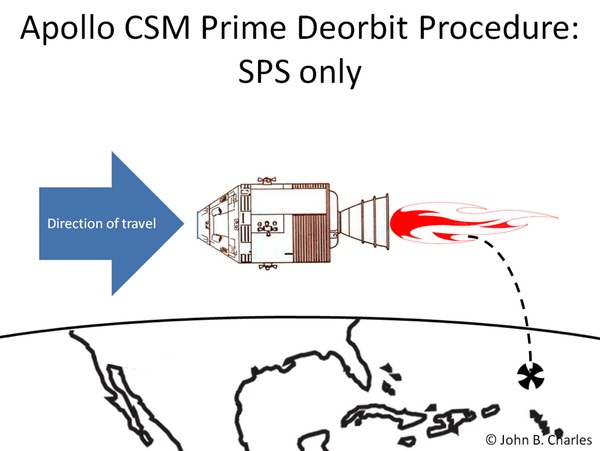 Figure 1 |
The SPS used hypergolic fuel and oxidizer that ignited on contact and therefore did not require an ignition system, effectively making it unlikely to have the malfunction that was fundamental to the movie. These were the same propellants used in the ascent stage engine of the Apollo lunar module (LM)—the one engine that absolutely, positively could not fail on a lunar mission, or the astronauts would be marooned on the Moon. In reality, the SPS, like the ascent stage engine, always worked. In his novelization, Caidin even lamented how ground troubleshooting was unable to reproduce the in-flight condition: the SPS in the test stand could not be made to fail no matter how the engineers tried.[11]
But, for the sake of drama, let’s accept Simon’s and Caidin’s SPS failure. In anticipation of such a malfunction, NASA planners had developed an alternate technique for deorbiting Apollo using smaller maneuvering thrusters (Figure 2). The Apollo service module mounted four reaction control system (RCS) “quads” of four thrusters each at 90-degree intervals around its circumference. Each quad had one thruster pointed aft, another forward, and one each to the left and right; the correct combination of thrusters allowed rotation about the pitch, yaw, and roll axes as well as translation forward, backward, to the left and right, and up and down.[12]
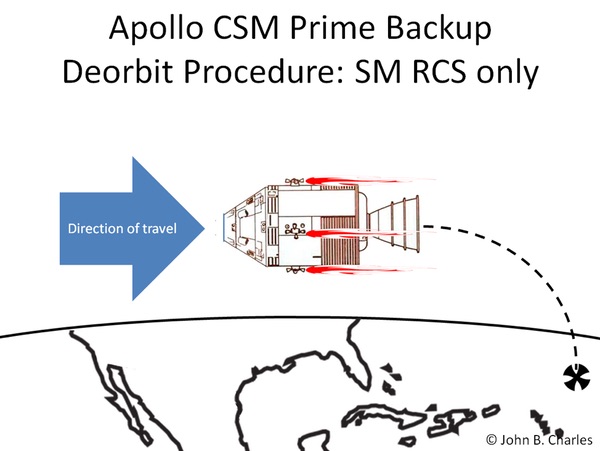 Figure 2 |
Clearly this was also an option familiar to the Ironman One crew. On being advised to prepare for a second attempt at reentry, spacecraft commander Pruett logically assumes that they will be using those aft-firing SM RCS engines, referred to in the movie as “backup thrusters.” This was standard procedure in Apollo planning and it was designated (without irony) as “the prime backup deorbit procedure” in a NASA planning document.[13] The late astronaut Donn Eisele explicitly referred to this option in his recently-published memoir about Apollo 7, the Earth-orbiting maiden test flight of Apollo: “There was plenty of reaction fuel for normal pre-entry maneuvers but we wanted to save all we could in case we had to use our attitude control thrusters for the deorbit burn. That is, in the unlikely event that the main rocket engine would crap out.”[14] Eisele had confidence in the SPS, perhaps because he had not seen Marooned yet.
Each of the RCS engines only had a thrust of 440 newtons, so even with all four aft-firing engines, the combined thrust would only be 1,760 newtons, about 1/50th that of the SPS, a shortcoming that would be overcome by firing them longer than the 19-second SPS burn time and accepting a longer and more gradual descent of the combined command-service module (CSM) spacecraft toward atmospheric entry, contrary to what some sources maintain.[15] The four SM RCS engines were radiatively-cooled with unlimited life, at least from a burn-time standpoint.[16]
When Pruett makes his logical assumption, given that the infallible SPS had inexplicably failed and should be considered unavailable, he is stunned by the response from Mission Control: that the RCS has fallen too low on fuel for the deorbit maneuver, and even too low on fuel to return to the space station from which they had only recently departed and which still had many months of life support capability, unlike their CSM.
This revelation bothered me the first time I saw the movie 50 years ago and continues to bother me on each re-viewing, for two reasons.
First: how could they be too low on fuel for a pre-planned backup procedure if they made only the prescribed maneuvers during their transits to and then away from the station? Both Simon’s screenplay and Caidin’s novelization are silent on any extravagant fuel usage up to that point, but a real-world analog to the flight of Ironman One can give us a clue.
The first Skylab CSM carried 606 kilograms of fuel in its standard RCS tanks, and consumed 574 kilograms during all of its rendezvous, fly-around, and station-keeping maneuvers including docking with Skylab and then, nearly a month later, undocking from it, so the final quantity constituted only five percent of the initial standard fuel load.[17] Thus, the typical maneuvers really would have nearly exhausted the standard RCS fuel supply.
But, each Skylab CSM also carried an additional “propellant storage module” in the SM that more than doubled the available RCS capacity with 689 kilograms of added propellant, just in case the surefire SPS failed, requiring an RCS deorbit. Maybe the Skylab planners learned the lesson from Marooned and added the extra fuel module, but more likely they provided adequate safety margins of fuel as dictated by good engineering analysis—unlike their fictional counterparts who seemed to be caught off guard, especially if they had planned for a year-long mission.
| In its quest for drama, the movie and its novelization missed one and possibly two additional procedures that real astronauts would have been aware of and trained on. |
If it was not profligate fuel usage that depleted Ironman One’s maneuvering fuel, then perhaps it was an undetected leak. This nearly happened on the second Skylab mission, when the SM’s RCS system did in fact begin leaking and a rescue mission was initiated. Rescue would have come not in the form of the chief astronaut flying an untested lifting body vehicle, but instead in the form of two specially-trained backup Skylab astronauts flying a specially-outfitted Skylab rescue CSM up for the save. In the event, however, the leak was controlled, the rescue effort was discontinued, and the SM RCS and SPS functioned normally for undocking and an expedited deorbit maneuver.
The second and more important aspect of my discomfort is why the dismal RCS fuel quantity, whether by reckless usage or unnoticed leak, came as a surprise to Pruett, who not only had fuel gauges on his instrument panel[18] just inches from his face but also had a vested interest in knowing the quantities, as did the two other astronauts, Lloyd and Stone, sitting to his right. The only answer to this question must be “dramatic license”: the writers needed a way to initiate the action, and they chose that one.
It is at this point that Simon and Caidin declare hopelessness, forcing “Head of Manned Space” Charles Keith to discard pages of mandatory pre-launch checkout procedures to launch Dougherty in a conveniently available, untested spacecraft atop a non-man-rated rocket through the eye of a hurricane on a desperate rescue mission whose success is enabled only by the selflessness of Pruett during a dramatic impromptu spacewalk[19] and a well-intentioned but futile Soviet rescue attempt.
Ironically, in its quest for drama, the movie and its novelization missed one and possibly two additional procedures that real astronauts would have been aware of and trained on. If executed promptly, they might have saved all three men without reliance on Dougherty or the Soviets.
The first procedure is described in that non-ironic NASA document as a “secondary backup deorbit procedure” comprising a combination of maneuvers known as the “hybrid deorbit.”
“The hybrid deorbit consisted of an SM RCS [sic] followed by a CM/SM separation and a CM RCS burn. This maneuver sequence is performed about apogee so that an optimum effective ∆V [that is, velocity change—in this case, deceleration] is achieved and a 40 n. mi. [74 km] vacuum perigee can be obtained from the available propellants.”[20]
This hybrid deorbit is not widely known today, was apparently never mentioned in the press in the Apollo era, and is surprisingly rare in programmatic documents of that era. Besides the non-ironic NASA document, I have only found one reference[21] to it in the online Tindallgram archive, memos written by William Tindall documenting Apollo spacecraft and ground control “mission techniques.”
In a hybrid deorbit, the service module’s RCS thrusters would have been fired at the orbit’s high point, or apogee, until they ran out of fuel, to lower the orbit’s low point, or perigee, just enough for the capsule to enter the atmosphere. When the SM thrusters ran out, the SM (with its tons of unused fuel for the failed SPS engine) would have been jettisoned, leaving only the lighter command module with its own RCS motors. This is where it gets interesting.
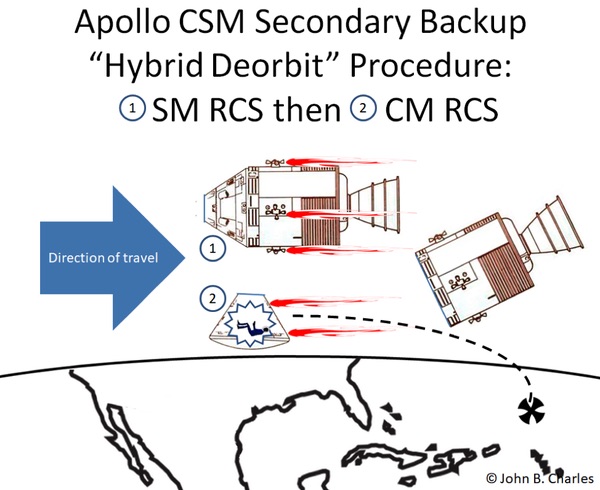 Figure 3 |
Early in its development, a CM RCS technique for translation was established.[22] The Apollo CM, unlike the preceding Mercury and Gemini capsules, had RCS motors both above and below its center of mass (Figure 3). While intended for rotational attitude control during reentry, they could also have been used for translation—including deceleration and deorbiting—if fired simultaneously in the proper combinations. Specifically, the pair of “positive pitch” thrusters near the nose was normally used to pitch the CM nose-down, and the pair of “negative pitch” thrusters near the heat shield normally pitched the CM nose upward (Figure 4). If used together, they could have created a directional movement in the astronauts’ footward direction. If the CM were reoriented such that the astronauts were flying head-first—instead of blunt heat shield forward—then firing the forward and aft pitch RCS thrusters simultaneously would decrease the vehicle’s orbital velocity and hasten re-entry. The CM RCS engines were certified for the 200-second deorbit burns that would be required for the hybrid deorbit. Thruster performance degradation was allowed, but engine structural integrity had to be maintained for this type of burn.
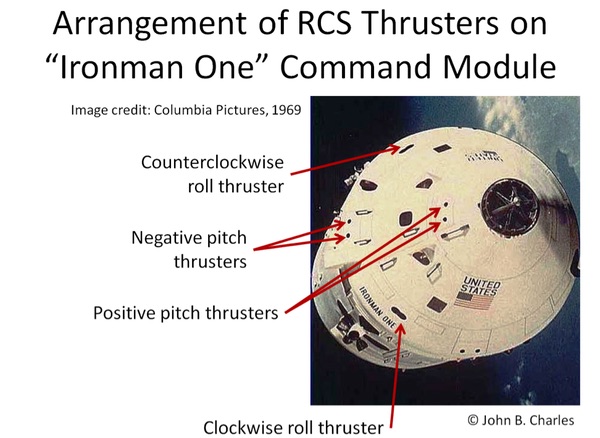 Figure 4 |
Alternatively, coupling the forward pitch thrusters with the two opposing roll thrusters positioned around the circumference of the base of the CM might also have had the same effect.
These maneuvers would not have been easy, requiring simultaneous but opposing inputs from two separate rotational hand controllers operated by two different astronauts, one commanding a pitch down and the other, a pitch up, with special care taken that the direction of the thrust was maintained correctly. However, similar two-man coordination was demonstrated during Apollo 13 when one astronaut used the LM translation thrusters to control pitch and yaw and the other used the LM attitude thrusters to control roll of the docked CSM-LM during an important maneuver.
Interestingly, none of these documents indicates whether this portion of the hybrid deorbit would have employed the two sets of pitch engines (with the roll thrusters used just for attitude control) or the positive pitch and opposing roll thrusters. I just assume the first option was preferred.
If that the SM RCS thrusters really were low on fuel, there was still a second possibility, which I have named the “tertiary backup deorbit procedure” in the fashion of the same NASA document: it was just the CM-only step (Figure 5). Eisele seems to have had this capability in mind on Apollo 7 as well: “[W]e still had enough fuel left in our [service module] reaction rockets to get us out of orbit—and if they didn't work we could use the control rockets on the Command Module.”[23] Thus the real Apollo astronauts in low Earth orbit were comforted by the knowledge of two-fold additional redundancy of which their fictional contemporaries were unaware.
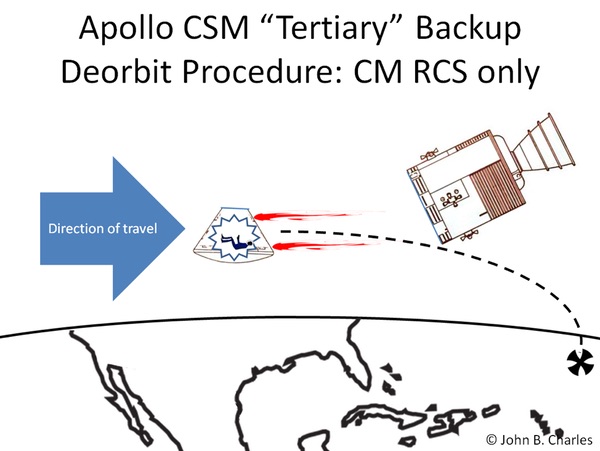 Figure 5 |
These secondary and tertiary backup procedures would both result in shallower re-entries and possibly less control of the command module during re-entry due to RCS fuel depletion. They would require continuous burn times of about 200 seconds—reaching the service life of those thrusters—using two pairs of RCS thrusters.[24] If they could not successfully deorbit the command module, then perhaps they could lower the perigee enough for the orbit to decay and re-entry to occur before the module’s limited oxygen was used up. I have not found documentation of command module lifetime after jettisoning the service module, but Apollo 13 provides the longest example of the Apollo program: 2 hours, 30 minutes between CM power-up and start of re-entry.[25] That is less time than two Earth orbits, a plausible interval in which orbital decay must occur for the crew to survive.
| Marooned was one of those space movies that try to adhere to realistic limitations and established physical principals in order to showcase the contributions of human fortitude, persistence, and ingenuity in overcoming adversity and conquering space. It is ironic that the engineers planning for worst-case scenarios in reality were more imaginative than the writers of science fiction based on that reality. |
These procedures were apparently well-understood by Apollo mission planners, if not by science fiction writers, and must have been documented in procedures manuals. However, except for Eisele’s comment and a casual mention a long time ago deep within the Internet, I have not found an explicit mention of the CM-only deorbit maneuver, much less descriptions of which thruster pairs were to be selected, how they were to be controlled, how the vehicle was to be oriented, and what the operational implications of such a deorbit procedure would have been. Nor was the single Apollo astronaut I recently consulted able to recall such an alternative deorbiting procedure—although the events of the intervening five decades including a moon mission and a successful corporate career may have displaced it from his memory.
If Marooned had utilized the higher-order backup procedures described here, Col. Pruett’s noble sacrifice might have been replaced by a demonstration of detailed planning and preparation. However, the resulting movie would not have been as interesting or as memorable to a generation of space exploration aficionados, and would not have included a fictional Soviet rescue attempt that encouraged the joint ventures that have dominated real-world human space activities for two decades. Marooned was one of those space movies that try to adhere to realistic limitations and established physical principals in order to showcase the contributions of human fortitude, persistence, and ingenuity in overcoming adversity and conquering space. It is ironic that the engineers planning for worst-case scenarios in reality were more imaginative than the writers of science fiction based on that reality.
Endnotes
- Caidin, M., Marooned, E.P. Dutton and Co., Inc., New York, N.Y., 1964.
- Caidin, M., Marooned (special movie edition), Bantam Books, E.P. Dutton and Co., Inc., New York, N.Y., 1969.
- “Hurricane Alma (1970),” downloaded January 30, 2019.
- “Marooned (1969 film),” downloaded January 1, 2019.
- The set designers didn’t use the layouts then (circa 1967) being developed by McDonnell Douglas and the Marshall Space Flight Center but instead outfitted the OWS haphazardly with realistic, recognizable spaceflight furnishings.
- “Marooned (1969), Awards,” downloaded November 18, 2018.
- “Marooned (1969), Goofs,” downloaded November 18, 2018.
- Bartoli, R. (writer) and M. Drucker (artist), “Moroned,” Mad Magazine #138, October 1970, reproduced here, downloaded December 29, 2018.
- Sampo [sic], Episode Guide: 401 – Space Travelers, Mystery Science Theater 3000 Satellite News, October 1, 2015, downloaded January 1, 2019. The movie had more stars, the biggest budget, and the only Academy Award of the 200-plus movies that they had satirized. Comedian Dennis Miller criticized the MST3K treatment, speaking for hard-core mid-century movie technophiles who appreciate Marooned despite its shortcomings.
- Gibson, C.R., and J.A. Wood, Apollo Experience Report – Service Propulsion System, NASA TN D-7375, NASA, Washington, D.C., August 1973, downloaded Dec. 31, 2018.
- Caidin, 1969, p. 91.
- Taeuber, R.J., and D.P. Weary, Apollo Experience Report - Command and Service Module Reaction Control Systems, NASA TN D-7151, NASA, Washington, D. C., June 1973, downloaded January 1, 2019.
- Operational Abort Plan for the Apollo 9 Mission, Volume II, Contingency Deorbit, MSC Internal Note No. 69-FM-37, Feb. 13, 1969, Introduction, p. 2, downloaded January 16, 2017.
- Eisele, D., with F. French, Apollo Pilot, Chapter 9, Return to Earth, University of Nebraska Press, Lincoln, 2017, p. 81.
- “Marooned (1969), Goofs.”
- Taeuber and Weary, p. 9.
- “The Skylab 2 Mission Report, First Visit,” in: Steven-Boniecki, D., Skylab 1 & 2 - The NASA Mission Reports, Apogee Books, Burlington, Ont., 2015, pp. 129, 138.
- Taeuber and Weary, p. 8.
- It isn’t clear from either the movie or the novel how Pruett’s fatal excursion saves Lloyd and Stone since it involved not only dumping the cabin atmosphere with its residual oxygen, but also losing the remaining oxygen in Pruett’s life-support backpack that could have been used by the other two men if he had died less dramatically.
- Operational Abort Plan for the Apollo 9 Mission, p. 2.
- Tindall, William, “‘C’ Mission Retrofire and Reentry Mission Techniques Meeting,” July 23, 1968, downloaded May 26, 2019.
- Tauber and Weary, p. 2.
- Eisele, p. 95.
- Using both pairs of pitch thrusters plus the two opposing roll thrusters would reduce the burn time to 140 seconds at the cost of increased complexity in manual controlling the maneuver.
- “Apollo 13 Timeline,” NASA History Office, Washington, D.C., downloaded January 21, 2019, specifically: SM separation, 13:14:48 GMT; CM powered up, 15:23 GMT; LM jettisoned, 16:43 GMT; Entry, 17:53:45 GMT; Splashdown, 18:07:41 GMT.
Note: we are temporarily moderating all comments subcommitted to deal with a surge in spam.
